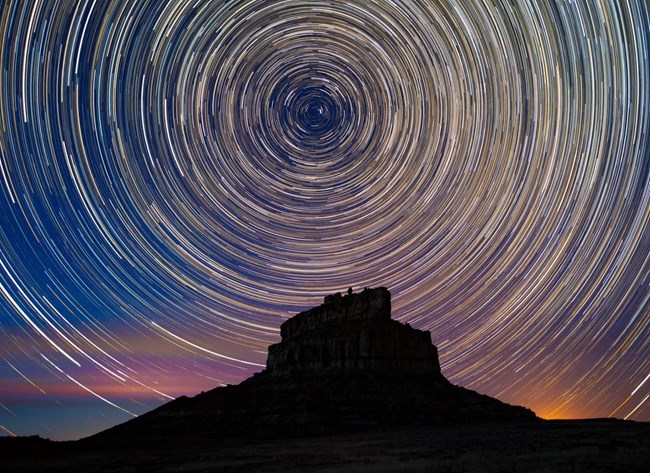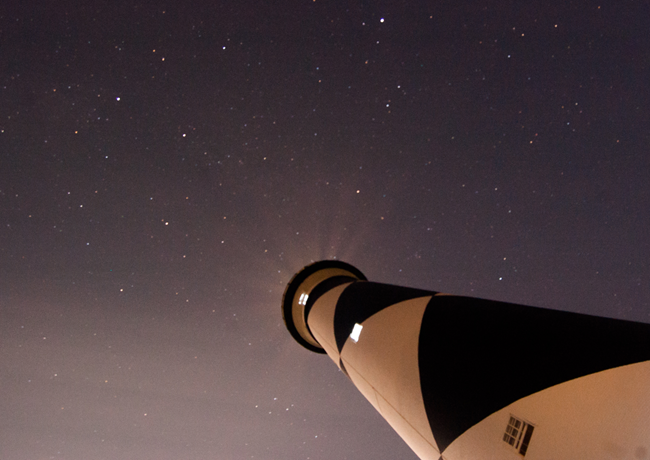
Cultural
Throughout history the night sky has shaped the beliefs and traditions of societies, from the Native American origin and cultural landscape stories, to the celestially-aligned architecture of ancestral Puebloan civilizations, to agricultural harvest festivals and nautical navigation records of sea voyages.
Fajada Butte solar alignment during Spring Equinox (aka The Sun Dagger).
The ancestral Puebloan people built a thriving society at Chaco Canyon around 850-1250 A.D. They built immense great houses and kivas and other engineering feats with astronomical alignments in mind. These sophisticated astronomical features enabled them to measure time and accurately track solstices, equinoxes, and lunar standstills for predicting the movements of the sun, moon, and various stars and planets. Large stones placed in perfect alignment atop Fajada Butte helped the ancestral Puebloans understand planting and harvest seasons. The modern Hopi and Zuni Pueblos are considered descendants of the ancestral Puebloan people, and they still use solar astronomy as an integral part of their agricultural and ceremonial life. Also, the dark night sky was critical for viewing fires atop tower kivas that were likely used as a form of communication between Chaco Canyon and outlier communities. In addition, pictographs and petroglyphs in national park units preserve stories of ancient astronomical events, such as the Supernova pictograph at Chaco Canyon thought to represent the star Crab Nebula explosion that occurred around July 1054 A.D. This culturally significant site is protected by the National Park Service as Chaco Culture National Historical Park and is also a certified International Dark Sky Park. There are many more parks that are certified dark sky places that offer educational programming and opportunities for star gazing and understanding the cultural heritage connection to the night sky.

NPS/Paul Terry
Historical
Naturally lit nighttime surroundings are part of the historic fabric of many national parks. Just as we keep historic structures intact and preserve surrounding landscapes and views of a given era, we also recognize the natural night sky as an important value of the historical context, setting and feel of the area. Experiencing a natural starry night helps us imagine Harriet Tubman using the guiding light of the north star as she led freedom seekers to safety. Also, viewing the night sky allows us to imagine the stars used as navigational beacons by the Polynesian wayfinders who explored the Pacific.
Protecting the lightscape of our national parks also includes preserving the authenticity of historic lights and light fixtures. The misapplication of modern lighting technology with inappropriate color, intensity, or fixtures can threaten the value of historic resources. Therefore, the NPS works closely with park staff, lighting designers, and the lighting industry to find solutions to maintain and restore the authentic historic lightscape of our parks, for example: historic lighthouses such as at Cape Lookout National Seashore, a certified dark sky park.
References
- Rogers, J. and Sovick, J. 2001.The Ultimate Cultural Resource?, The George Wright Forum, 18:4.
- Noble, David Grant. 1988. New Light on Chaco Canyon. Edited by Noble. An Issue of Exploration: the Annual Bulletin of the School of American Research. School of American Research Press, Third Printing, Santa Fe, New Mexico.
- High Altitude Observatory. Supernova Pictograph | High Altitude Observatory (ucar.edu). Accessed 6/10/2022.
- Who or What is Chaco? (archaeologysouthwest.org). Accessed 6/15/2022
Last updated: July 24, 2025
